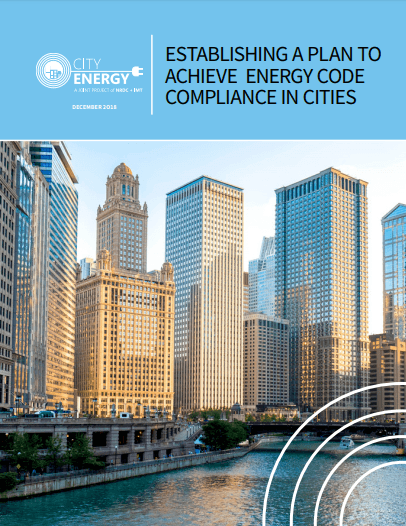
The building energy code is an important tool that states, counties, and cities have to meet their climate and energy goals. As government leaders take more ambitious steps to reduce carbon emissions and provide healthier and more affordable places for people to live and work, it is critical to improve the code that sets minimum energy efficiency requirements and governs both new building projects and renovations to existing buildings.
Since the International Code Council (ICC) Public Comment Hearings for the 2021 International Energy Conservation Code (IECC) concluded in Las Vegas last month, I’ve put some thought into what code and government officials designated as Government Voting Representatives (GMVRs) should consider before casting their ballots between now and December 6. In jurisdictions where it gets adopted, the 2021 IECC will likely impact any project that triggers the need for a building permit. Thus, GMVRs have the opportunity to shape the building energy code of tomorrow and set a higher bar for building energy performance. With this in mind, below are five key considerations that officials should weigh before they vote.
1. Vote for measures that align with your state or local government’s goals.
Cities, states, and municipalities across the country have announced a variety of goals to improve building performance, cut carbon emissions, and increase renewable energy adoption. These goals are all worthwhile and achievable, but achieving them through the energy code is complicated by the interconnections of energy, carbon, and renewables. You can’t solve them all in one voting cycle, so it’s good to vote for proposals that line up with your jurisdiction’s goals. There are a host of energy efficiency and sustainability proposals from envelope to lighting that will reduce energy consumption, contribute to carbon and energy reductions, and make it easier to adopt renewable energy and advance the grid. However, I encourage you to read the fine print in these proposals and look at what they will actually achieve. What does it mean when a proposal says an energy code will be 5% or 10% better? Is it ensuring better-designed buildings? How does the code fit into net-zero energy, 100% renewable energy, or 80% carbon emissions reductions targets that many cities are aiming to accomplish?
2. Weigh the costs and benefits of a more efficient and advanced energy code.
Building officials need to continue to evolve and adopt best practices and smart, cost-effective technology solutions. Just as well, they must put their critical thinking skills to work in every codes cycle. The industry learns, develops, and changes a fair amount in between each three-year cycle. That knowledge and experience needs to be incorporated into code updates. For example, there are currently proposals for electric vehicle (EV) readiness, onsite solar, storage, and electrification infrastructure. When weighing costs and benefits of these proposals, account for more than first costs. It will cost more to make a building EV- or solar-ready, however, there are significantly more cost savings achieved if done at the time of construction than if a building owner were to do a retrofit and add these technologies later. By making sure codes are updated with best practices and have factored in advanced energy and technology changes, it ensures buildings are designed and constructed to modern standards and are also ready for any policies that would require these upgrades in the future.
3. Don’t vote against a measure because you think the industry can’t achieve it.
The ICC process ensures that building experts, efficiency advocates, code officials, and industry representatives have all had the opportunity to vet the proposals in front of you today. The energy code development is meant to keep the minimum floor of requirements moving up—jurisdictions should rely on advanced policies and third-party programs to push the ceiling, and then use the code to bring along the stragglers and secure market transformation.
4. Be cautious of proposals that look minimal.
At first glance, some proposals may look like they are pursuing changes that are minimal. However, some of these proposals have significantly more impact than a quick read will uncover. Consider if the changes are necessary to improve usability or enforcement. Consider if the change may in practice create a loophole that did not previously exist. As I noted earlier, GMVRs must put their critical thinking skills to work in every codes cycle—that includes giving proposals the appropriate level of analysis.
5. Be cautious of proposals that look too good to be true.
They may be. In addition to taking an extra few minutes to read the proposal in its entirety, you may want to consider reviewing the public comments that were filed, both the positive and the negative, and watching video of the testimony from the Committee Action Hearings and the Public Comment Hearings (both available to GMVRs through cdpAccess). I don’t advocate this much attention to every proposal— some will be cut and dry—but if a proposal is sending out red flags to you, these are good steps to gather necessary information before casting your vote.
Every Vote Counts
GMVRs are considered to have knowledge and technical expertise that others do not. To recap, you should apply your expertise and critical thinking before voting on a proposal and make sure it aligns with the goals of your jurisdiction. Every vote is important, and every proposal deserves your attention. The online governmental vote is open today through December 6, 2019.
For those seeking more in-depth information on 2021 code proposals, I am offering a “phone a friend” option as the online voting begins: if you have questions on a proposal and would like to talk it through, drop me a line at kimberly.cheslak@imt.org. Use the subject line “URGENT – IECC Voting Question” and include a phone number and the best times to reach you. I will call you as quickly as I am able.
Want to learn more? Here are some great energy code resources to check out:
- Energy Efficient Codes Coalition Voting Guide
- New Buildings Institute’s “IECC Process Explained” webinar and blog
- Natural Resources Defense Council blog

